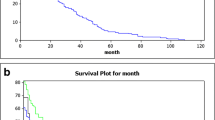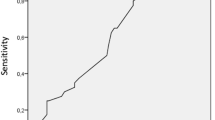Abstract
Purpose
The likelihood of a stoma following ileocolic resection (ICR) for Crohn’s disease (CD) is an important consideration. This study aims to identify the factors associated with an increased likelihood of a stoma and develop a predictive scoring system (SS).
Methods
Patient data were collected from St. Marks Hospital, London, UK and Humanitas Clinical and Research Center, Milan, Italy, on all patients who underwent an ICR for CD from 2005 to 2017. A logistic regression analysis was used for multivariate analysis. The SS was developed from the logistic regression model. The performance of the SS was evaluated using receiver operating characteristics area under the curve (AUROC).
Results
A total of 628 surgeries were included in the analysis. Sixty-nine surgeries were excluded due to missing data. The remaining 559 were divided into two cohorts for the scoring system’s development (n = 434) and validation (n = 125). The regression model was statistically significant (p < 0.0001). The statistically significant independent variables included sex, preoperative albumin and haemoglobin levels, surgical access and simultaneous colonic resection. The AUROC for the development and validation cohorts were 0.803 and 0.905, respectively (p < 0.0001). Youden’s index suggested the cut-off score of − 95.9, with a sensitivity of 87.6% and a specificity of 62.9%.
Conclusions
Male sex, low preoperative albumin, anaemia, laparoscopic conversion and simultaneous colonic resection were associated with an increased likelihood of requiring a stoma and were used to develop an SS. The calculator is available online at https://rebrand.ly/CrohnsStoma.


Similar content being viewed by others
References
Lee Y et al (2012) A laparoscopic approach reduces short-term complications and length of stay following ileocolic resection in Crohn’s disease: an analysis of outcomes from the NSQIP database. Colorectal Dis 14(5):572–577
Gardiner KR, Dasari BV (2007) Operative management of small bowel Crohn’s disease. Surg Clin North Am 87(3):587–610
Bernell O, Lapidus A, Hellers G (2000) Risk factors for surgery and recurrence in 907 patients with primary ileocaecal Crohn’s disease. Br J Surg 87(12):1697–1701
Lowney JK, Dietz DW, Birnbaum EH, Kodner IJ, Mutch MG, Fleshman JW (2006) Is there any difference in recurrence rates in laparoscopic ileocolic resection for Crohn's disease compared with conventional surgery? A long-term, follow-up study. Dis Colon Rectum 49(1):58–63. https://doi.org/10.1007/s10350-005-0214-6
Dibley L et al (2018) Patient decision-making about emergency and planned stoma surgery for IBD: a qualitative exploration of patient and clinician perspectives. Inflamm Bowel Dis 24(2):235–246
Kuruvilla K, Osler T, Hyman NH (2012) A comparison of the quality of life of ulcerative colitis patients after IPAA vs ileostomy. Dis Colon Rectum 55(11):1131–1137. https://doi.org/10.1097/DCR.0b013e3182690870
Gustafsson UO et al (2019) Guidelines for perioperative care in elective colorectal surgery: Enhanced Recovery After Surgery (ERAS(®)) Society recommendations: 2018. World J Surg 43(3):659–695
YOUDEN WJ (1950) Index for rating diagnostic tests. Cancer 3(1):32–35. https://doi.org/10.1002/1097-0142(1950)3:13.0.co;2-3
Koskenvuo L, Lehtonen T, Koskensalo S, Rasilainen S, Klintrup K, Ehrlich A, Pinta T, Scheinin T, Sallinen V (2019) Mechanical and oral antibiotic bowel preparation versus no bowel preparation for elective colectomy (MOBILE): a multicentre, randomised, parallel, single-blinded trial. Lancet 394(10201):840–848. https://doi.org/10.1016/S0140-6736(19)31269-3
Krouse RS, Herrinton LJ, Grant M, Wendel CS, Green SB, Mohler MJ, Baldwin CM, McMullen CK, Rawl SM, Matayoshi E, Coons SJ, Hornbrook MC (2009) Health-related quality of life among long-term rectal cancer survivors with an ostomy: manifestations by sex. J Clin Oncol 27(28):4664–4670. https://doi.org/10.1200/JCO.2008.20.9502
Krouse R et al (2007) Quality of life outcomes in 599 cancer and non-cancer patients with colostomies 138(1):79–87
Vonk-Klaassen SM, de Vocht HM, den Ouden ME, Eddes EH, Schuurmans MJ (2016) Ostomy-related problems and their impact on quality of life of colorectal cancer ostomates: a systematic review. Qual Life Res 25(1):125–133. https://doi.org/10.1007/s11136-015-1050-3
Bass EM et al (1997) Does preoperative stoma marking and education by the enterostomal therapist affect outcome? Dis Colon Rectum 40(4):440–442
Cakir SK, Ozbayir T (2018) The effect of preoperative stoma site marking on quality of life. Pakistan J Med Sci 34(1):149–153
Person B, Ifargan R, Lachter J, Duek SD, Kluger Y, Assalia A (2012) The impact of preoperative stoma site marking on the incidence of complications, quality of life, and patient's independence. Dis Colon Rectum 55(7):783–787. https://doi.org/10.1097/DCR.0b013e31825763f0
Chaudhri S et al (2005) Preoperative intensive, community-based vs traditional stoma education: a randomized controlled trial. Dis Colon Rectum 48(3):504–509
McMahon KR et al (2020) Predicting post-operative complications in Crohn’s disease: an appraisal of clinical scoring systems and the NSQIP surgical risk calculator. J Gastrointest Surg 24(1):88–97
Wickramasinghe D et al (2021) A scoring system to predict a prolonged length of stay after surgery for Crohn’s disease. Colorectal Dis 23(5):1205–1212
Brant SR, Nguyen GC (2008) Is there a gender difference in the prevalence of Crohn’s disease or ulcerative colitis. Inflamm Bowel Dis 14((suppl_2)):S2–S3
Dotson JL et al (2015) Assessment of sex differences for treatment, procedures, complications, and associated conditions among adolescents hospitalized with Crohn’s disease. Inflamm Bowel Dis 21(11):2619–2624
Auzolle C et al (2018) Male gender, active smoking and previous intestinal resection are risk factors for post-operative endoscopic recurrence in Crohn’s disease: results from a prospective cohort study. Aliment Pharmacol Ther 48(9):924–932
Lipska MA et al (2006) Anastomotic leakage after lower gastrointestinal anastomosis: men are at a higher risk. ANZ J Surg 76(7):579–585
Law WI et al (2000) Risk factors for anastomotic leakage after low anterior resection with total mesorectal excision. Am J Surg 179(2):92–96
Don BR, Kaysen G (2004) Poor nutritional status and inflammationa: Serum Albumin: Relationship to Inflammation and Nutrition. Semin Dial 17:432–437. https://doi.org/10.1111/j.0894-0959.2004.17603.x
Shental O, Tulchinsky H, Greenberg R, Klausner JM, Avital S (2012) Positive histological inflammatory margins are associated with increased risk for intra-abdominal septic complications in patients undergoing ileocolic resection for Crohn's disease. Dis Colon Rectum 55(11):1125–1130. https://doi.org/10.1097/DCR.0b013e318267c74c
Joksimović V et al (2014) "Risk factors for early postoperative complications after surgery for Crohn's disease." Acta Facultatis Medicae Naissensis 31.3:147–154
Benjamin J, Makharia GK, Kalaivani M, Joshi YK (2008) Nutritional status of patients with Crohn's disease. Indian J Gastroenterol 27(5):195–200
Suding P et al (2008) Definitive risk factors for anastomotic leaks in elective open colorectal resection. Arch Surg 143(9):907–912
Ghoneima AS et al (2019) High risk of septic complications following surgery for Crohn’s disease in patients with preoperative anaemia, hypoalbuminemia and high CRP. Int J Colorectal Dis 34(12):2185–2188
Liu X et al (2017) Preoperative hypoalbuminemia is associated with an increased risk for intra-abdominal septic complications after primary anastomosis for Crohn’s disease. Gastroenterology Report 5(4):298–304
Yamamoto T, Allan RN, Keighley MR (2000) Risk factors for intra-abdominal sepsis after surgery in Crohn's disease. Dis Colon Rectum 43(8):1141–1145. https://doi.org/10.1007/BF02236563
Schreiber S et al (1996) Recombinant erythropoietin for the treatment of anemia in inflammatory bowel disease. N Engl J Med 334(10):619–623
Mary JY, Modigliani R (1989) Development and validation of an endoscopic index of the severity for Crohn’s disease: a prospective multicentre study Groupe d’Etudes Therapeutiques des Affections Inflammatoires du Tube Digestif (GETAID). Gut 30(7):983–9
Daperno M et al (2004) Development and validation of a new, simplified endoscopic activity score for Crohn’s disease: the SES-CD. Gastrointest Endosc 60(4):505–512
Rimola J et al (2009) Magnetic resonance for assessment of disease activity and severity in ileocolonic Crohn’s disease. Gut 58(8):1113–1120
Pariente B et al (2011) Development of the Crohn’s disease digestive damage score, the Lemann score. Inflamm Bowel Dis 17(6):1415–1422
Spinelli A et al (2012) Laparoscopic surgery for recurrent Crohn’s disease. Gastroenterol Res Pract 2012:6
Schmidt CM et al (2001) Laparoscopic surgery for Crohn’s disease: reasons for conversion. Ann Surg 233(6):733–739
Masoomi H et al (2015) Risk factors for conversion of laparoscopic colorectal surgery to open surgery: does conversion worsen outcome? World J Surg 39(5):1240–1247
Toh JW et al (2016) Indications and surgical options for small bowel, large bowel and perianal Crohn’s disease. World J Gastroenterol 22(40):8892–8904
El-Hussuna A et al (2012) Biologic treatment or immunomodulation is not associated with postoperative anastomotic complications in abdominal surgery for Crohn’s disease. Scand J Gastroenterol 47(6):662–668
Myrelid P et al (2014) Complications in surgery for Crohn’s disease after preoperative antitumour necrosis factor therapy. Br J Surg 101(5):539–545
Author information
Authors and Affiliations
Contributions
DW, AS and JW conceptualised the study. DW, MC, FC, AM, SA, KS and PM collected the data and analysed the results. All authors contributed to the drafting and revision of the article and approved the final manuscript.
Corresponding author
Ethics declarations
Competing interests
The authors declare no competing interests.
Additional information
Publisher's note
Springer Nature remains neutral with regard to jurisdictional claims in published maps and institutional affiliations.
Electronic supplementary material
Below is the link to the electronic supplementary material.
Rights and permissions
Springer Nature or its licensor holds exclusive rights to this article under a publishing agreement with the author(s) or other rightsholder(s); author self-archiving of the accepted manuscript version of this article is solely governed by the terms of such publishing agreement and applicable law.
About this article
Cite this article
Wickramasinghe, D., Carvello, M., Di Candido, F. et al. Factors associated with stoma formation in ileocolic resection for Crohn’s disease and the development of a predictive scoring system. Langenbecks Arch Surg 407, 2997–3003 (2022). https://doi.org/10.1007/s00423-022-02626-1
Received:
Accepted:
Published:
Issue Date:
DOI: https://doi.org/10.1007/s00423-022-02626-1




